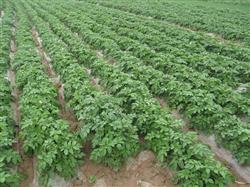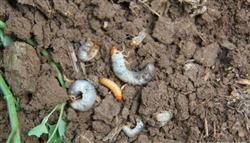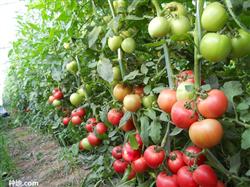How to grow virus-free spring potatoes?

How to grow virus-free spring potatoes? Please guide the cultivation of virus-free spring potato with reference to the following methods: (1) according to local conditions, select improved varieties: virus-free potato has the advantages of virus-free, high emergence rate, neat growth and yield increase by more than 30%. At present, the virus-free potato varieties suitable for planting in our city are Dongnong 303, Xiang potato No. 1 (early maturity), E potato No. 5 (medium maturity) and so on. (2) Fine soil preparation and ridging cultivation: potato is a shallow root tuber crop that is not tolerant to continuous cropping. For fear of waterlogging, potato and other Solanaceae crops must be selected, with flat terrain, irrigation conditions and good drainage. Sandy loam with deep plough layer and loose ventilation. After the former crop was harvested, 50 picoles of fence fertilizer per mu and 25 kilograms of compound fertilizer were turned into the soil as base fertilizer. Before sowing, the furrow depth was 10 cm, the width of the ditch was 40 cm, the width of the box was 2 m, and the row spacing of each box was 0.5 m. The plant spacing was 25 cm, and the plant spacing was about 4400 cm per mu. (3) sowing at the right time, covered with plastic film: before sowing, the seed potato is cut into pieces according to 20ml 25g (20m / kg), each piece has 3 bud holes (cut into four squares, do not cut into thin slices), cool and dry cut water is mixed with plant ash and sown before and after the Winter Solstice (late December) sowing, 150kg seeds per mu, 25kg phosphate fertilizer mixed with soil miscellaneous ash fertilizer 20 piculs per mu are used as seed fertilizer, and fine soil is covered after sowing. In the first ten days of January, after the mu was drenched with water with urea and potash fertilizer of 5kg and potash fertilizer respectively, the plastic film was laid flat on the side of the box (about 10kg per mu), and the surrounding area of the film was pressed with crushed soil. (4) due to seedling management, drought resistance and waterlogging prevention: let the seedlings grow in the film after they were unearthed in the middle and late February. At the end of February and the beginning of March, when the seedlings grew to more than 15 cm and the temperature rose to about 10 ℃, the membrane was removed (it can be reused in the coming year). If the film is not removed, when the seedlings are unearthed in late February, the seedlings are drilled out of the membrane by hand and sealed with broken soil, and the cracks in the membrane are found during the whole growth period. Prevent the breeding of weeds. In case of drought around late January, ditch irrigation moist chamber soil when the soil is dry (90% of the seedlings without plastic film are ploughed once, at the same time, 10 kg of urea is drenched with water as fertilizer for raising seedlings, and the soil is cultivated for 2 cm, weeding and weeding again when the seedling is 20 cm high, 10 kg of urea is used as potato fertilizer before budding, and then ploughing and cultivating the soil once after budding). It is necessary to clear the ditch and drain water in time after each heavy rain in March. (5) spraying paclobutrazol to control diseases and insect pests: for seedlings with long buds, large leaves, tender and weak branches and leaves, 15% paclobutrazol was sprayed with 50 grams of water and 50 kilograms of water per mu. It was found that aphids were sprayed with 10% imidacloprid 20 grams of water and 60 kilograms of water. 25% insecticidal Shuang 150 grams of water was used to control aphids. Late blight disease was found (light brown spot appeared at the leaf tip or leaf edge at the beginning, the periphery of the spot was yellow-green, when the humidity was high, the spot was enlarged, the leaf surface was flooded, and there was white fog outside the spot). Agricultural streptomycin, Kangkuling or downy mildew were used to control the disease. It was found that bacterial wilt (the main stem or individual branches suddenly wilted and wilted at the onset of the disease, the other stems and leaves grew normally temporarily, and soon the whole plant died), the mildly diseased plants were irrigated with 0.1% potassium permanganate solution, or the diseased plants were completely removed and burned and disinfected with quicklime. Click to get more potato planting techniques click to get more vegetable planting techniques
- Prev

How to control underground potato pests?
How to control underground potato pests? The main underground pests of potatoes are grubs and golden needles. The more convenient method to control these two kinds of pests is to use seed potato coating and furrow application when sowing. Seed potato coating can choose 70% thiazine dispersible seed treatment agent, according to 100 kg seed potato.
- Next

How to grow tomatoes in the open air in South China
How to grow tomatoes in the open air in the south? Please give an introduction to guide the open-air cultivation of tomatoes in the south, you can refer to the following methods: first, the quantitative index of tomato high-yield cultivation: tomato temperature requirements: tomato likes temperature, the suitable temperature in daytime is 25 ℃-28 ℃, night 16 ℃-18 ℃. Below 15 ℃, tomato seeds germinated.
Related
- Where is it suitable to grow horseradish in China? it is expected to see the middle altitude horseradish in Alishan.
- How to prevent tomato virus disease reasonably? (Control methods included)
- Many people like to plant towel gourd on the balcony. What are the main points of this method and management?
- What crops can chili peppers be mixed with?
- Fertilization techniques and matters needing attention in Tomato
- What are the grafting techniques for peach seedlings in spring?
- Harm and control methods of root swelling disease of Chinese cabbage
- What are the pests of sweet potatoes? How to prevent and cure it?
- Symptoms, causes and Control methods of navel Rot in Tomato
- The cause of "Cucumber rotten bibcock" in Farmers' planting Cucumber and its Control Plan

